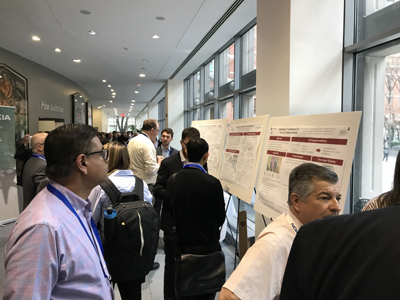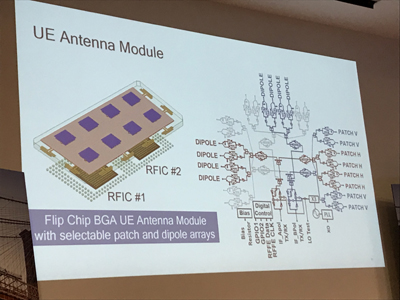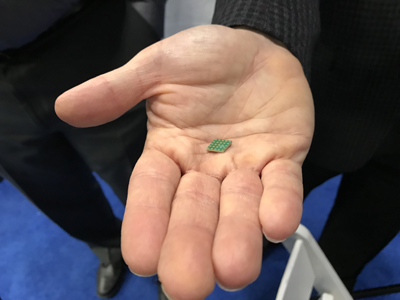The Brooklyn 5G Summit celebrated its 5th meeting for 2018 at NYU WIRELESS. Leaders and technologists from leading operators such as AT&T, DoCoMo, KT, T-Mobile US, Verizon and Vodafone discussed the latest results and plans for future 5G networks. In addition, major infrastructure leaders like Nokia, Ericsson and Huawei, plus smaller companies such as Phazer, Blue Danube, BluWireless and InterDigital, were on hand showing off the latest results and technology. It was the most exciting 5G Summit to date by many accounts, as the rollout of 5G starts this year with the accelerated standards and deployment schedule from a few years ago.
 As the main sponsor, Nokia (along with their Bell Labs division) featured the latest advances in mmWave hardware, full network automation with AI, and 5G-enabled remote, automated control for a variety of 5G applications. One scenario they showed was where an oil truck over turns creating an emergency with cameras and sensors monitoring a city block. The AI network adaptively adjusts the capacity to give first responders more priority and bandwidth while other non-essential activities take a secondary priority. The smart sensors also adjust traffic flow around the incident to avoid severe backups – a glimpse of the future.
As the main sponsor, Nokia (along with their Bell Labs division) featured the latest advances in mmWave hardware, full network automation with AI, and 5G-enabled remote, automated control for a variety of 5G applications. One scenario they showed was where an oil truck over turns creating an emergency with cameras and sensors monitoring a city block. The AI network adaptively adjusts the capacity to give first responders more priority and bandwidth while other non-essential activities take a secondary priority. The smart sensors also adjust traffic flow around the incident to avoid severe backups – a glimpse of the future.
I first talked with Prof. Ted Rapparport, founding director of NYU WIRELESS, as he discussed the roll out of 5G mmWave Fixed Wireless Access (FWA) later this year (Verizon) and mobile 5G starting the end of this year too (AT&T). He is hoping that Santa will deliver the first 5G handset for Christmas, but it will probably be next year. mmWave technology provides “Wireless Fiber” performance for FWA and is best suited for rural and urban small cell applications. The FCC has licensed the 28 GHz band and plans to auction off other bands in the twenty GHz range and possibly in the 39 GHz band. A couple of drawbacks are indoor penetration is poor so system repeaters are needed inside of structures plus propagation distances, compared to lower frequencies, are reduced. However, Ted noted that his NYUSIM propagation model is now an option in the 3GPP standards and predicts about double the capacity/spectral efficiency as the other model which are not based on measurements like NYUSIM. He was the first to demonstrate that mmWave communications performance was suitable for commercial use.
 Dr. Peiying Zhu, Huawei Fellow, reviewed the 5G NR notable Layer 1 features from her point of view which was a great way to sum up the first 5G NR release:
Dr. Peiying Zhu, Huawei Fellow, reviewed the 5G NR notable Layer 1 features from her point of view which was a great way to sum up the first 5G NR release:
- Soft Air Interface (Hybrid Numerology/Slot/Frame)
- New Waveform F/W-OFDMA
- New Coding (Polar, LDPC)
- Ultra Low Latency (Special Slot and Transmission Mechanism)
- New Transmission Mode (Grant Free)
- New Access Scheme (UCNC)
- Enhanced MIMO (Massive MIMO)
- mmWave Transmission (Beam Centric IP/CP)
Huawei’s results for 5G NR TDD at 3.5 GHz show a 10x improvement in user experience and 1/10 the latency and cost per bit providing better capacity and coverage for many of their applications.
An area that was mentioned by many speakers was factory automation and results of testing were reviewed by Mikael Hook, Director of Radio Research at Ericsson. They performed testing using 5G NR TDD at 3.5 GHz in a 100 m square factory with 10 assembly lines and 280 robots including metallic blockers. They achieved availability of 99.999% reliability in 1 ms using 6 sectors of advanced beamforming and 100% availability in 100 MHz. They will continue to test this type of scenario and expect improvements with Rel 16.
 The most interesting portion of the program for me and most microwave engineers was the phased array presentations by Qualcomm and Intel along with others displayed in the exhibition. Qualcomm’s Ozge Koymen presented 5G UE 28 GHz phased array results using their 2x2 antenna arrays in various configurations around the phone typically placing them in 2x4 rectangular formations to the phone edge or face. They compared hand blockage measurements to the 3GPP models and found that the flat 30 dB loss is too pessimistic, EM simulations cannot capture blockage accurately, and simple log normal model sufficient to model loss. Multiple modules do provide good spherical coverage and they compared edge versus face module positioning. Since most handsets are moving to full face screens, edge positioning is more likely going to be a necessity.
The most interesting portion of the program for me and most microwave engineers was the phased array presentations by Qualcomm and Intel along with others displayed in the exhibition. Qualcomm’s Ozge Koymen presented 5G UE 28 GHz phased array results using their 2x2 antenna arrays in various configurations around the phone typically placing them in 2x4 rectangular formations to the phone edge or face. They compared hand blockage measurements to the 3GPP models and found that the flat 30 dB loss is too pessimistic, EM simulations cannot capture blockage accurately, and simple log normal model sufficient to model loss. Multiple modules do provide good spherical coverage and they compared edge versus face module positioning. Since most handsets are moving to full face screens, edge positioning is more likely going to be a necessity.
The transceiver architecture operates from 26.5 to 29.5 GHz using 100 to 800 MHz of bandwidth. It has 3 bit passive phase shifters with IF active mixers operating at 6.5 GHz and an LO of 20-23 GHz with an external or on chip VCO at 6.6 to 8.15 GHz. Per channel 1 dB gain control steps were implemented for taper, gain leveling and equalizing gain per channel versus phase setting, if needed. It is made using the 28LP-RF 1P7M process. Two RFICs are flip chip (BGA) mounted to a 2x4 antenna array module with selectable patch and dipole arrays. The scanning angle is +/- 45 degrees. With 64QAM OFDM, PAE is 7.5% with 6 dBm Pout and using 64QAM SCFFDM, PAE is 12% at 8 dBm Pout.
Their optimized design includes 8x RFFE modules in 4x locations for testing flexibility and is based on the 5G NR Rel 15 specification using adaptive beamforming and beam tracking. Each module supports multiple selectable antenna sub-arrays scanning in 3 dimensions supporting 5G NR interoperability testing and OTA trials with global operators. Handsets will be available from some manufacturers in 2019.
 Intel’s Baljit Singh discussed how they have demonstrated several mmWave arrays including 27-30 GHz 2x4, 4x4 and 4x4x4 dual polarized arrays plus 37-40 GHz 4x4 dual polarized array. They covered their mobility solution for automobiles that uses the 4x4x4 arrangement of phased arrays to provide 360 degree coverage on top of the vehicle. The 4 panel solution provides panel switching, beam selection, beam switching time optimized and is refined for mobility. It operates from 26.5 to 29.5 GHz and the PLLs are combined in the design to minimize phase noise. In their testing, buses and large trees created big blockers but system was optimized with good results. He had some interesting comments at the end about the future of phased arrays:
Intel’s Baljit Singh discussed how they have demonstrated several mmWave arrays including 27-30 GHz 2x4, 4x4 and 4x4x4 dual polarized arrays plus 37-40 GHz 4x4 dual polarized array. They covered their mobility solution for automobiles that uses the 4x4x4 arrangement of phased arrays to provide 360 degree coverage on top of the vehicle. The 4 panel solution provides panel switching, beam selection, beam switching time optimized and is refined for mobility. It operates from 26.5 to 29.5 GHz and the PLLs are combined in the design to minimize phase noise. In their testing, buses and large trees created big blockers but system was optimized with good results. He had some interesting comments at the end about the future of phased arrays:
- mmWave RFIC operation needs to by multiband (28 and 39 plus possibly 60 GHz)
- Antennas need to steer over wider angles
- Multi-band phased arrays will be needed
- Active null steering
- Further optimization is needed to support 256QAM
The most interesting comment here is the multiband phased arrays and said these are already being worked on by combining 28 and 39 GHz operation into a single array (39 GHz antenna arrays are inter-dispersed between 28 GHz elements).
 In the exhibition area, Nokia Bell Labs and DOCOMO were showing a 90 GHz phased array. They used a Nokia Bell Labs developed compact mmWave phased-array antenna system scalable up to 256 elements using an RFIC designed by Nokia Bell Labs to enable multi-gigabit per second speeds. The test demonstrated how using 5G NR enhancements at mmWave frequency bands can manage radio complexity and a larger number of antenna beams, while enabling greater bandwidth. They also showed how using a larger number of antenna elements at higher frequency bands can minimize pathloss to enable coverage similar to that found using lower mmWave bands. Since it is at 90 GHz, the array is very small as shown in the picture. In addition, NYU displayed their work at 140 GHz using 4 GHz of bandwidth and doing channel sounding and channel modeling using a unit supplied by VDI.
In the exhibition area, Nokia Bell Labs and DOCOMO were showing a 90 GHz phased array. They used a Nokia Bell Labs developed compact mmWave phased-array antenna system scalable up to 256 elements using an RFIC designed by Nokia Bell Labs to enable multi-gigabit per second speeds. The test demonstrated how using 5G NR enhancements at mmWave frequency bands can manage radio complexity and a larger number of antenna beams, while enabling greater bandwidth. They also showed how using a larger number of antenna elements at higher frequency bands can minimize pathloss to enable coverage similar to that found using lower mmWave bands. Since it is at 90 GHz, the array is very small as shown in the picture. In addition, NYU displayed their work at 140 GHz using 4 GHz of bandwidth and doing channel sounding and channel modeling using a unit supplied by VDI.
R&S and NI had displays showing their measurement solutions for 5G applications. R&S was showing the measurement of sub-6 GHz 5G NR signals using their vector signal generator feeding into their VNA for measurement. The signals have 100 MHz of bandwidth and different numerologies are analyzed. NI has teamed up with Advantest to offer full systems solutions and showed a 28 GHz 5G analysis and measurement solution at the event. View these brief video demonstrations.
 Throughout the Summit, the main impediments to 5G mentioned were access to fiber, real estate availability and approval delays for basestations, more spectrum, and compatibility with 802.11 WLAN. There was also already talk about 6G which could utilize the 70-90 GHz mmWave frequencies and perhaps even higher frequencies in the 100-250 GHz range. The use of AI and cloud RAN is expected to make the networks intelligent and able to automatically adapt to various conditions and scenarios. In addition, DARPA is experimenting with cognitive radio technology where the radios will automatically sense frequencies being used and transmit on ones that are not being used to avoid interference and better utilized the spectrum. Finally, the inventor of the cell phone, Marty Cooper, was in attendance and honored at the dinner reception with the first Brooklyn 5G Summit award given in its 4 years. It is the most interesting time in our industry as technology is rapidly evolving.
Throughout the Summit, the main impediments to 5G mentioned were access to fiber, real estate availability and approval delays for basestations, more spectrum, and compatibility with 802.11 WLAN. There was also already talk about 6G which could utilize the 70-90 GHz mmWave frequencies and perhaps even higher frequencies in the 100-250 GHz range. The use of AI and cloud RAN is expected to make the networks intelligent and able to automatically adapt to various conditions and scenarios. In addition, DARPA is experimenting with cognitive radio technology where the radios will automatically sense frequencies being used and transmit on ones that are not being used to avoid interference and better utilized the spectrum. Finally, the inventor of the cell phone, Marty Cooper, was in attendance and honored at the dinner reception with the first Brooklyn 5G Summit award given in its 4 years. It is the most interesting time in our industry as technology is rapidly evolving.

